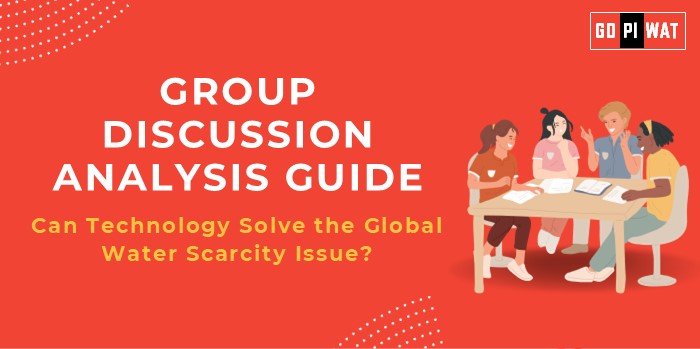📋 Group Discussion Analysis Guide
🌊 Can Technology Solve the Global Water Scarcity Issue?
🌐 Introduction to the Topic
Opening Context: “Water scarcity affects more than 2 billion people worldwide, posing one of the greatest challenges of the 21st century. The intersection of science, technology, and sustainable practices is critical in addressing this crisis.”
Topic Background: The global water scarcity issue stems from increasing demand due to population growth, climate change, and inefficient water management systems. Technological advancements, such as desalination and smart water grids, offer potential solutions to mitigate this challenge.
📊 Quick Facts and Key Statistics
- 2.1 billion people lack access to safe drinking water (UNICEF, 2023).
- 70% of freshwater is used in agriculture, leading to inefficiencies and over-extraction.
- 33% increase in water demand is projected by 2050 due to population growth.
- Advanced desalination technologies now process over 100 million cubic meters of water daily worldwide.
👥 Stakeholders and Their Roles
- Governments: Policymaking, funding for technology adoption, and public water supply.
- Private Sector: Innovating solutions like water recycling and IoT-based water management.
- NGOs and International Organizations: Promoting awareness, research funding, and local-level implementation.
- Citizens: Reducing water wastage and supporting conservation programs.
🏆 Achievements and Challenges
✔️ Achievements
- Desalination Success: Countries like Israel meet 85% of water needs through desalination.
- Smart Water Grids: Singapore’s water management reduced leakages to 5% (global average: 15-20%).
- Water Recycling Innovations: California reuses 90% of treated wastewater for irrigation.
- Low-Cost Purification: Advancements in graphene filters have reduced water purification costs by 20%.
⚠️ Challenges
- High Costs: Desalination remains expensive, requiring $0.50-$3.00 per cubic meter.
- Energy Consumption: Technologies like desalination are energy-intensive, emitting significant CO2.
- Infrastructure Gaps: Many regions lack the initial setup for implementing smart water systems.
- Global Comparisons: While Israel leads in water technology, regions in Sub-Saharan Africa remain technologically underserved.
📜 Case Study
Cape Town, South Africa, averted “Day Zero” through emergency water restrictions, public awareness campaigns, and technology-aided management.
💬 Structured Arguments for Discussion
- Supporting Stance: “Technological advancements, such as desalination and AI-based water management, are pivotal in reducing water scarcity.”
- Opposing Stance: “Reliance on technology alone is unsustainable due to high costs and limited accessibility for underdeveloped regions.”
- Balanced Perspective: “While technology offers promising solutions, its success depends on cost reduction, inclusive access, and global cooperation.”
✨ Effective Discussion Approaches
- Opening Approaches:
- “Did you know that by 2050, water demand will surpass supply by 40% globally? Technology must step in to bridge this gap.”
- “With Israel achieving near self-sufficiency in water through innovation, why can’t similar efforts succeed worldwide?”
- Counter-Argument Handling:
- “While cost is a valid concern, breakthroughs in solar-powered desalination are reducing dependency on fossil fuels.”
- “Technology must complement—not replace—traditional methods like rainwater harvesting.”
📈 Strategic Analysis: Strengths and Weaknesses
Strengths
- Proven technologies like desalination and IoT solutions.
- Global interest in addressing water security.
Weaknesses
- High operational and maintenance costs.
- Dependence on energy-intensive processes.
Opportunities
- Integration with renewable energy for sustainable operation.
- Scaling community-based water management projects.
Threats
- Cybersecurity risks in smart grids.
- Climate change exacerbating water availability unpredictably.
🔗 Connecting with B-School Applications
- Real-World Applications: Sustainability projects integrating water technology and operations-focused case studies on cost efficiency in water tech.
- Sample Interview Questions:
- “How can technology-driven solutions for water scarcity impact economic growth?”
- “Discuss the role of public-private partnerships in solving water issues.”
- Insights:
- Explore startups in water technology.
- Study global water management practices for operational strategies.


